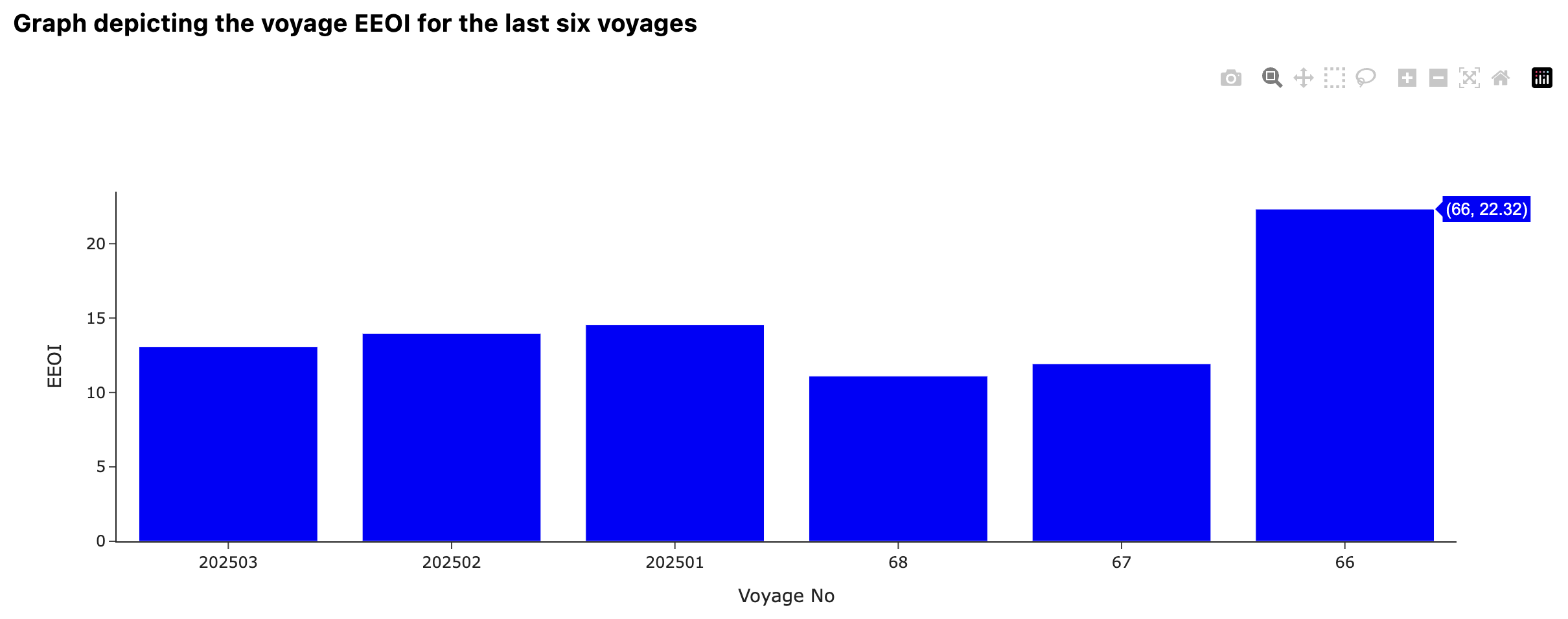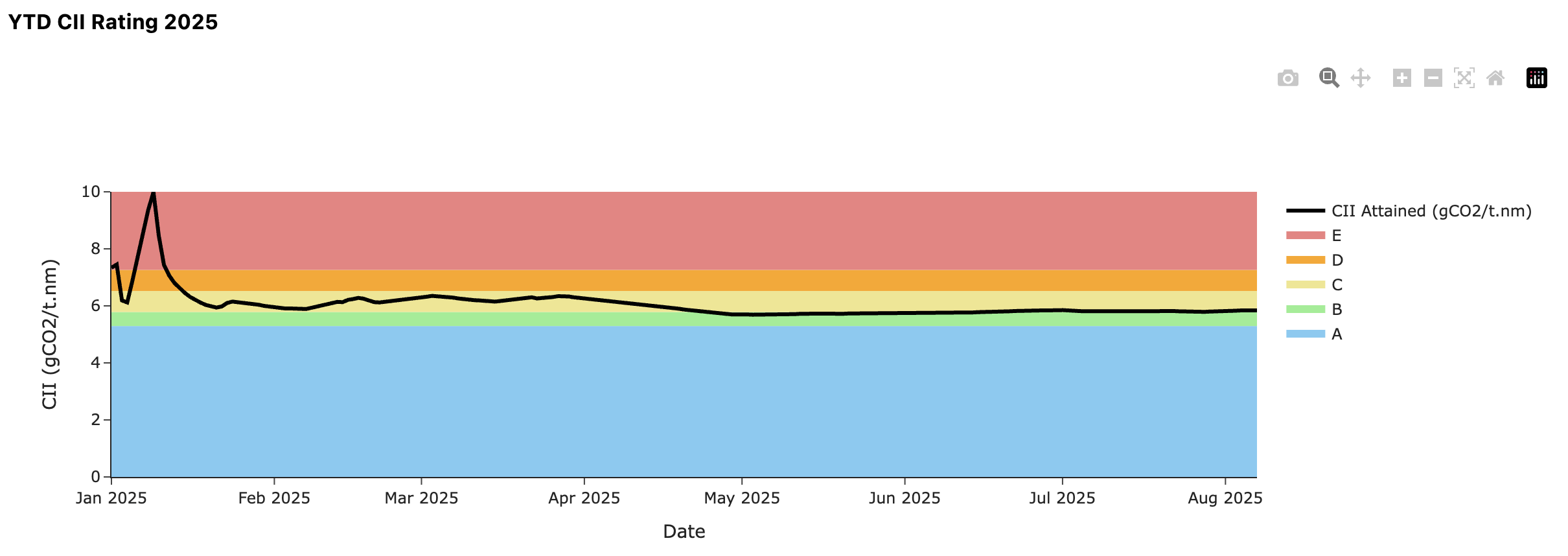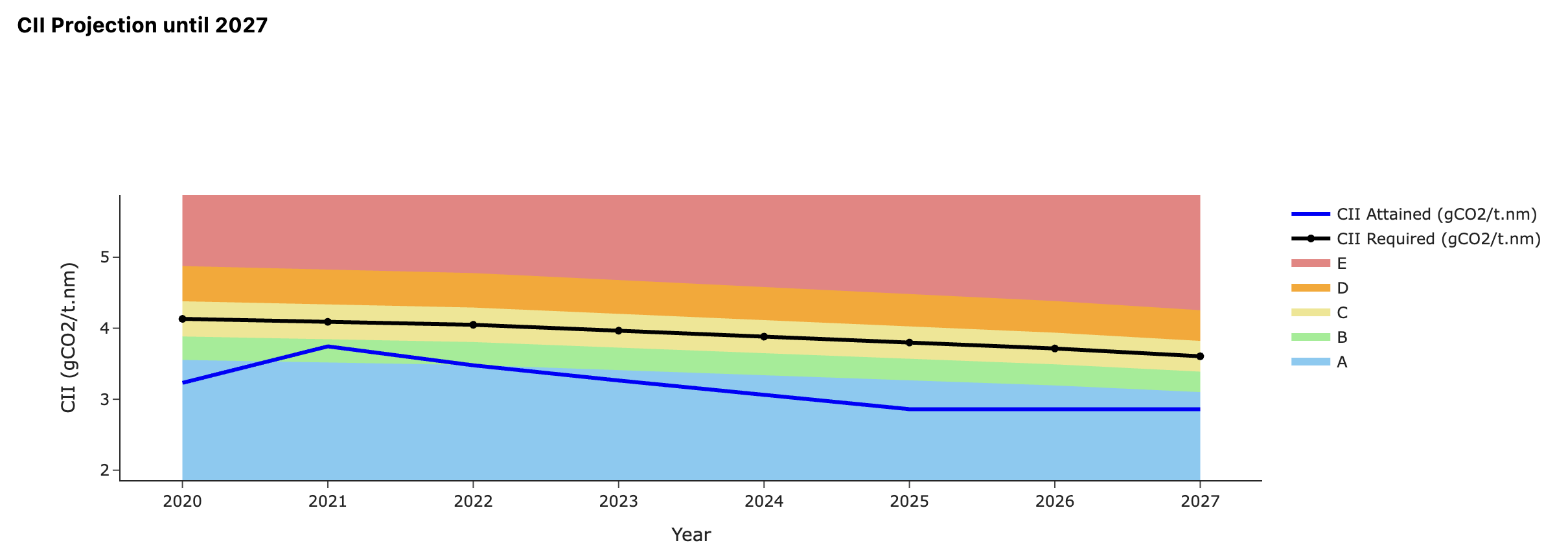
📝The Challenge
Managing vessel efficiency and staying ahead of evolving IMO regulations is a significant operational challenge. This module transforms complex fuel consumption, voyage, and event data into a clear, actionable dashboard, giving you a real-time command center for your fleet’s environmental performance.How It Works: From Data to Decision
Module Components
Component 1: EEOI Analysis
Key Features:
- Voyage-by-voyage analysis
- Fuel consumption tracking
- Transport work calculation
- Efficiency benchmarking
Component 2: CII Rating System
Key Features:
- Real-time CII calculation
- A-E rating classification
- Multi-year projections
- Boundary visualization
Data Sources & Integration
Primary Data Sources
- ERP Systems - Vessel voyage and operational data
- Vessel Consumption Logs - Fuel consumption by grade and type
- Vessel Events Database - Sea, harbor steaming, anchorage, and port activities
- Vessel Particulars - Technical specifications and deadweight tonnage
- IMO DCS Data - International Maritime Organization Data Collection System
Core Algorithms & Calculations
This section provides a detailed mathematical and practical breakdown of the key performance indicators used for emissions monitoring, focusing on the core principles behind each calculation.EEOI (Energy Efficiency Operational Indicator) Calculation
The EEOI is a crucial metric standardized by the IMO to measure the operational energy efficiency of a vessel. It provides a real-world assessment of a ship’s performance by relating CO₂ emissions to the actual “transport work” performed. Mathematical Formulation: This formula quantifies the vessel’s efficiency by calculating the total CO₂ emissions generated from all fuel types during a specific voyage and normalizing it by the useful work done. The concept of “transport work” (cargo mass multiplied by distance) is central here, as it ensures that the metric reflects how efficiently a vessel is transporting its cargo. A lower EEOI value signifies higher efficiency, meaning less CO₂ is emitted for every tonne of cargo moved one nautical mile. Where:i: Voyage numberj: Fuel typeFCᵢⱼ: Mass of fuel of typejconsumed during voyagei(in tonnes)CFⱼ: Carbon Factor for fuel typej, representing the mass of CO₂ emitted per mass of fuel consumed (t-CO₂/t-Fuel)m_cargo: Cargo mass carried during the voyage (in tonnes), representing the payload.D: Distance travelled over the ground during the voyage (in nautical miles)
CII (Carbon Intensity Indicator) Calculation
The CII is a regulatory framework designed to drive continuous improvement in the operational carbon intensity of vessels. It compares a ship’s actual performance against a legally mandated target, resulting in an annual rating from A to E. Attained CII Formulation: This formula calculates the vessel’s actual, or “attained,” carbon intensity. It represents the real-world CO₂ emissions per unit of transport capacity over a calendar year. Unlike EEOI, which uses actual cargo mass, CII uses the vessel’s deadweight tonnage (DWT) as a proxy for its transport capacity, providing a standardized measure across different operational conditions. Where:M: Total mass of CO₂ emitted in a calendar year (in grams)W: Vessel’s deadweight tonnage (DWT), a measure of its maximum carrying capacity.D: Total distance travelled in a calendar year (in nautical miles)
Z, to a reference CII value. The Z-factor increases over time, meaning the Required CII becomes progressively stricter each year, compelling owners to continuously improve their vessel’s operational efficiency to maintain compliance.
Where:
Z: The annual reduction factor (as a percentage), mandated by the IMO to drive decarbonization.CII_ref: The reference CII value, established for a specific vessel type and size based on historical data.
Required CII, creating five distinct performance levels.
- Superior Boundary (A/B):
d₁ = ((100 - C₁) / 100) × CII_required - Lower Boundary (B/C):
d₂ = ((100 - C₂) / 100) × CII_required - Upper Boundary (C/D):
d₃ = ((100 - C₃) / 100) × CII_required - Inferior Boundary (D/E):
d₄ = ((100 - C₄) / 100) × CII_required
Cₙ values are specific, pre-defined percentage thresholds established by the IMO. Each Cₙ value corresponds to a different performance rating level and is used to create the upper and lower bounds for the A, B, C, D, and E ratings. For example, an Attained CII that is below the calculated boundary d₁ achieves the highest rating, ‘A’.
CII Rating Logic:
The final rating is determined by comparing the Attained CII to these four calculated boundaries.
Dashboard Features & Interactions
EEOI Dashboard Features
- Voyage Selection Filter: Last 6 completed voyages
- Interactive Bar Charts: EEOI values per voyage
- Export Functionality: Data export for further analysis

Calculated EEOI for Vessel's Voyages
CII Rating Dashboard Features
- Year-to-Date Tracking: Live Current year performance monitoring
- Multi-year Projections: 2024-2027 rating forecasts
- Boundary Visualization: Performance thresholds display
- Comparative Analysis: Historical rating trends

Live Year-to-Date CII rating for an active vessel.

Projected CII ratings for future years based on IMODCS verified data and current performance.
Drill-down: Factors Influencing CII
The module allows for a deeper analysis of the specific factors from a vessel’s profile that are impacting its CII rating. This helps in identifying key areas for operational improvement.
Detailed breakdown of vessel profile components and their effect on the overall CII score.
Data Quality & Limitations
⚠️
Data Quality Assurance
- Automated validation of consumption log entries
- Cross-reference checks between ERP systems
- Outlier detection for unrealistic consumption values
- Completeness verification before calculation processing
Known Limitations
- Data dependency on accurate ERP system reporting
- Historical data gaps may affect trend analysis accuracy

